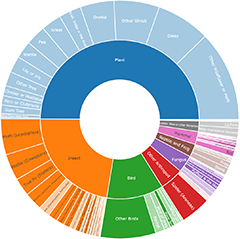Stinkhorns: with a smelly, brownish spore slime
The feature common to the fungi of this group is that, when mature, there is a smelly, brownish slime somewhere on the surface of the fruitbody. For those who have not had the joy of encountering a stinkhorn, think of a pit toilet or rotting meat and you get an idea of the aroma – though the strength of the smell varies between species. That slime contains the spores and attracts dung-loving or carrion-loving insects that act as dispersal agents.
Stinkhorns vary considerably in shape when mature. However, another thing that they all have in common is that each fruitbody starts out like a small egg, the 'egg shell' being a membrane that envelopes the immature fruit body. Initially the ‘egg’ is fairly firm but becomes softer as development proceeds. Finally, the fruitbody expands, breaks through the membrane and assumes its mature shape.
Warnings
The ‘egg’ may be buried in leaf litter or soil and could be mistaken for an immature puffball or make you think you’ve found a truffle.
Top contributors
- TimL 21
- AaronClausen 5
- Teresa 5
- Illilanga 5
- KMcCue 4
- MatthewFrawley 4
- Csteele4 4
- SandraH 4
- JBrickhill 4
- AliClaw 3
Top moderators
- MichaelMulvaney 50
- Heino1 44
- Heinol 39
- Csteele4 24
- Teresa 15
- Heino 12
- Pam 9
- KenT 6
- MichaelBedingfield 3
- PatriciaDaly 2




